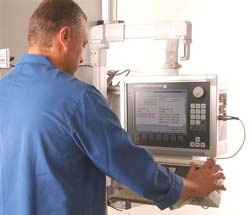
Posted to News on 20th Nov 2011, 14:44
How to choose the right press technology for assembly operations
Roger Ilett, the General Manager of Schmidt Technology Ltd, explains the different press technologies and how to choose the right one for a given application.

Press assembly technology has undergone considerable development in recent years. It has evolved from simple hand-operated presses, through pneumatic or hydro-pneumatic presses with force and stroke monitoring, to sophisticated electromechanical servo presses. Manual presses rely on an operator input for control, while more advanced systems are capable of providing almost unlimited control options with previously unachievable levels of precision and repeatability, in a wide range of industries such as automotive, aerospace, medical, petrochemical, testing and processing.
Servo presses are becoming increasingly common and can essentially be grouped into three main categories. These range from the most basic models that feature a simple servo actuator mechanism with a motor and spindle used to generate force, through advanced units with a range of control devices, to highly intelligent, fully-integrated purpose-built systems with real-time data processing, closed-loop force control and dynamic compensation for system, tooling and part compression and relaxation.
While these diverse presses offer an impressive range of features that meet the functional needs of many production tasks - including assembling, flaring, joining, pressing, testing, bending, embossing, forming, stamping and riveting - choosing the correct press for each specific application is not always straightforward. In today's economic climate, there is no room for costly mistakes, so the specification of electromechanical presses requires careful thought to achieve the ideal solution.
Press types
A basic servo actuator, for example, is normally used in automation machines for simply moving parts between locations; these devices are, however, also suitable for basic pressing operations, acting as a ram unit. Basic presses provide users with the flexibility to control both the ram position and speed. They cannot provide true closed-loop force control, but instead measure force via the torque of the motor or by using an external load cell. Depending on the specific needs of each application, a variety of control packages can be included and the options vary depending on the supplier and system builder used.
On the other hand, high-end servo actuators that have been designed to function as presses often feature several additional mechanical components, including planetary roller screw spindles for higher forces, mechanical clutches, integrated load cells and guided anti-rotational rams. In terms of control, there are various software programs available that can monitor and manage the press operation; they are not, however, capable of providing true closed-loop force control.
The most sophisticated servo press systems effectively incorporate all the features of high-end servo actuators and servo press systems, as well as using other additional components, to significantly increase functionality and enable users to produce extremely high quality parts. These systems often use completely integrated controls, designed specifically for pressing applications, to monitor the total pressing operation and achieve unparalleled levels of precision, while the extremely high-speed data transmission capabilities enable real time processing, providing true closed loop force control.
Integrated safety
Furthermore, these high-performance systems have been specifically designed to operate in industrial environments and, as such, feature integrated safety circuits, to minimise any electromagnetic interference (EMI) present in the surrounding area, as well as incorporating a motor cooling system. The latest servo press systems, such as those from Schmidt Technology, are also typically modular in design and use proven technology to offer both OEMs and end users an extensive range of options in many different applications.
By comparing these differences in mechanical design, while looking at how the systems control and monitor both position and force during the press cycle against an application's specific needs, engineers can select the right device, whether it be a manual, pneumatic, hydro-pneumatic or a servo press system. Indeed, by paying particular attention to factors such as throughput rate, accuracy, repeatability, the degree of automation required and system integration, a correctly specified press will start to play an important role in enhancing product quality, improving process performance and increasing productivity.
Want the latest machine building news straight to your inbox? Become a MachineBuilding member for free today >>















